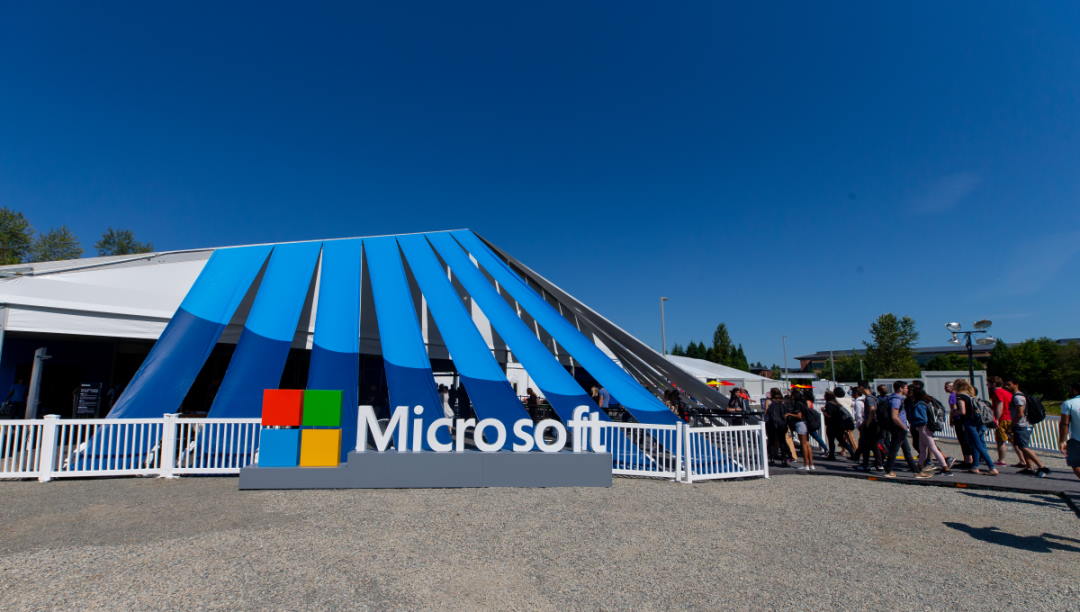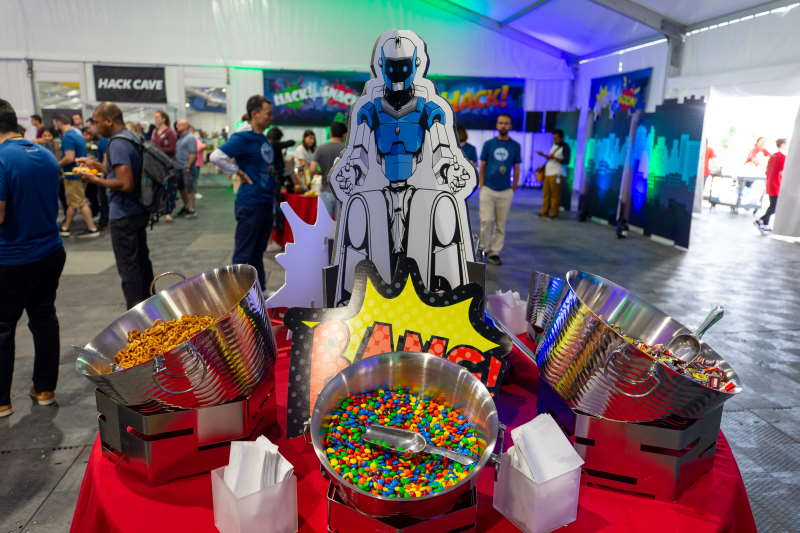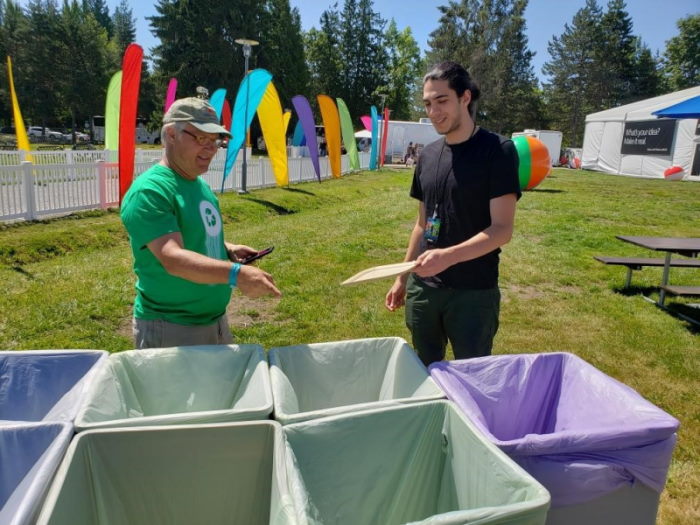While Microsoft’s Puget Sound campus has achieved Zero Waste Certification since 2016, the Hackathon was the first Microsoft event to achieve that honor in 2018, and again in 2019. With sustainability as a priority, the Hackathon planning teams share details of what it means to be zero waste.
Every summer Hackathon brings together employees from different disciplines and organizations, along with customers, nonprofits, students and teachers, to build on the ideas that inspire them. Typically, Hackathon’s presence energizes the Redmond campus in the form of football-field sized tents accommodating thousands of participants who gather to hack on projects. This year, participants will experience the same lively and inspiring energy, in collaboration with enthused colleagues, from within the comforts of their home. An endeavor as large as the Hackathon experience requires careful planning and thoughtful solutions to reduce the event’s carbon footprint and grow more sustainable each year.
 Participants of Hackathon 2019 in Redmond entering the Hackathon tents. Photo credit: Scott Eklund
Participants of Hackathon 2019 in Redmond entering the Hackathon tents. Photo credit: Scott Eklund
Early this year Microsoft’s leaders announced the company’s commitment to be carbon negative by 2030, reducing and removing direct carbon emissions and emissions across supply chains. Environmental responsibility and sustainability have been a priority driving both large- and small-scale efforts at the company. Microsoft’s new Silicon Valley campus will be the first tech campus with Net-Zero Water certification. Projects born from employee passion like FarmBeats help farmers around the world sustainably grow and manage their crops. At Microsoft’s global Hackathon, the world’s largest private hackathon with participation from employees in nearly 70 countries, a Sustainability Challenge was set forth calling for projects to accelerate innovation and environmental sustainability across the company and around the globe.
While Microsoft’s Puget Sound campus has achieved zero waste certification since 2016, Hackathon was the first Microsoft event to achieve Zero Waste Certification in 2018, and was re-certified in 2019. According to Green Business Certification Inc., the certification program’s goal is to divert at least 90% of waste from the landfill, rating facilities with a point-based credit system on how well they perform “in minimizing their non-hazardous, solid wastes and maximizing their efficiency in the use of resources.”
What does zero waste look like at Microsoft Hackathon?
In 2018, the Hackathon planning team alongside vendors and suppliers brought more awareness to sustainability, installing customized signage around the working space in the tents and the food areas. Expertly trained Zero Waste Ambassadors were stationed at disposal bins to help direct waste into the proper containers, ensuring all materials were sorted properly both at the front and back of house. Educational outreach coordinators helped participants be more aware of what items they used and discarded, the diligent SBM Janitorial staff used color coordinated bags to line disposal bins to distinguish between landfill, recycle, and compost, a best practice that has since been implemented for all campus-wide waste bins. The food and catering team switched to durable serving platters, which helped reduce the amount of compost material generated from the event by 3.8 tons, the weight of two mid-sized cars. Suppliers and vendors for Hackathon re-used materials from previous years, including furniture, carpet, pallets, and the tents themselves. These are a few of the initiatives that helped Hackathon achieve Gold-Level Zero Waste Certification in 2018.
By the next summer, Hackathon crews had identified additional opportunities for sustainability that built on the previous year’s successful model. New sustainability goals and standards achieved in 2019 included requirements for all event supplies to arrive with limited packaging and 100% recyclable packaging, publicizing waste reduction educational materials for attendees when they registered online for the event, requiring vendors to take responsibility for products and packaging, planning and tracking all environmentally preferred practices and products, and giving preference to vendors who embraced zero waste goals.
 Hackathon 2019 food and beverage area. Photo credit: Scott Eklund
Hackathon 2019 food and beverage area. Photo credit: Scott Eklund
2019 was also the second year that Hackathon had a single dining tent and kitchen, saving food and catering teams time and resources. Tim O’Brien, Director of Operations for catering, explained how this cut down on waste. “Having more than one kitchen causes some waste running back and forth between places. With a single kitchen and dining tent, we saved on transportation – all our routes back and forth are right-hand turns so vehicles were not sitting and idling, reducing our carbon footprint and prioritizing safety, with continuous routing back and forth. It makes things a lot more efficient.” Tim works with a team of 200 kitchen and catering staff that keep the hackers fed and happy from sunrise to sunset. They feed on average 40,000 meals daily during the Hackathon. “At base, we had everything pre-packed and ready to roll. Some of those efficiencies are translated to less vehicles on the road. We also used all electric golf carts on the Hackathon fields,” Tim explained.
From the durable serving platters, to meals that used only essential, natural ingredients, the catering team’s choices greatly reduced waste and cost.
But the biggest food-related efficiency in 2019 came in the form of replacing snack boxes with a bulk presentation of self-serve snacks. “This was the first year we truly felt we solved the snack dilemma,” said Kayte Caldwell, Production Planner with Eventions, Microsoft’s campus-wide event planning staff managed by Compass Group. “The snack boxes had caused a very interesting behavior where people would take more than they actually needed, or they wouldn’t eat certain items in the box, leading to more wasted food.” With the new snack bar presentation, participants only took what they wanted and in smaller portions, wasting less. Kayte worked closely with Tim and other stakeholders for the event, handling logistics and managing expectations across groups to ensure everyone could operate at their best.
For Hackathon participants who see what seems like an abundance of food, enough to feed thousands of hackers three meals a day, a valid concern might be ‘What happens to the leftover or un-eaten food?’ The reality is that careful planning and adjustments are made up until the very last moment about how much food is prepared, and during the event, catering staff are rigorously monitoring how much food should be served at any given time depending on the demand. All leftovers are composted, except for any food that has not been served which is donated to nonprofit organizations like Food Lifeline and Northwest Harvest.
 Hackathon 2019 food and beverage. Photo credit: Scott Eklund
Hackathon 2019 food and beverage. Photo credit: Scott Eklund
“We went from Gold level to Platinum-Level Zero Waste Certification, which is the highest level of certification, and I think that shows the hard work we put into it,” said Leah Tischler, Site Sustainability Manager with SBM who brought her knowledge and experience implementing strategies on campus to the Hackathon. Leah and her team were fundamental in helping Hackathon achieve Zero Waste Certification.
An important part of the sustainability efforts included re-using or up-cycling products, something that Leah hopes they can do more of in the future. In fact, over 200 tons of material was re-used from Hackathon 2019, everything from furniture to electronic waste to office supplies, including 1.25 tons in food donations.
During the event 11 tons of material including food waste and products were diverted from the landfill, commercially composted, and given new life with Cedar Grove, a local Washington industrial composting company who make their finished product available to consumers. “I’d like to find opportunities for waste reduction and integrate more of the circular economy process,” said Leah. “For example, we could use the compost to grow food on campus that we later consume.”
Rather than creating products from new materials, the circular economy approach is to use products and materials that already exist to reduce carbon emissions and generate less waste since less new material is created overall. Beyond Hackathon efforts, Microsoft Dining and those supporting Real Estate and Facilities have a long history of close collaboration, building synergies to develop and innovate new smart ways to be more sustainable on campus. Many of those tactics involved practicing a circular economy. “We recycle our cooking oil and make it into soap to use on campus,” explained Leah. “Whatever we send out for recycle, we always think about how we can bring it back to our events or on campus so it can serve another purpose.”
As society embraces more virtual meetings and telework, there is an opportunity for each person to be more conscientious of sustainability within their homes. Hackathon 2020 will follow the course of other large-scale events and become an all virtual event, creating a whole new set of challenges and opportunities. The frenetic energy of on-site Hackathon venues and gatherings will be translated into a deeper global connection felt from home offices, living rooms, and kitchen tables around the world. To engage participants on sustainability, Brad Smith is sponsoring this year’s Sustainability Challenge at Hackathon. The Sustainability Challenge will reflect the Microsoft’s ambition in addressing four resource areas: carbon, water, waste, and ecosystems. In addition to the Sustainability Challenge which will call for ideas and projects from employees and teams, there are plans underway to bring the sustainability message into the virtual Hackathon experience including programming, communications, and more tips for how every individual can minimize waste.
 Hackathon 2019 Waste Ambassador. Photo credit: Leah Tischler
Hackathon 2019 Waste Ambassador. Photo credit: Leah Tischler
“Waste prevention is the most effective way to reduce the amount of waste we create. Before you purchase, consider if there’s a need to buy that item you want,” said Alessandra Pistoia, Program Manager leading Microsoft’s global waste and circular economy program, spanning operations and products. Her charter is to help define corporate sustainability goals for waste and circularity, including events. Alessandra has expert knowledge on how to be more sustainable with waste from basic life hacks to more complex regulations around responsible materials management. “I encourage folks to take a moment to think before tossing anything away. First consider if it can be reused or redistributed to another organization, like Goodwill. If it needs to go out for curbside pickup, be sure to separate into the appropriate bin. By separating our waste materials into the right bin we support a healthy recycling system and minimize the amount of waste that goes to a landfill. Know where things go before you throw.”
Alessandra also pointed out that it is important to remember sustainability can be practiced as individual or collective action. Impact can be made at any scale. Individual efforts to reduce what you buy or repair a broken object make a positive impact personally and at a global scale. Similarly, if as a society we practice sustainable materials management, we will see the optimization of material use and less waste generated overall. In the end the goal is a universal one – improving quality of all life, together.
Read more about Microsoft’s commitment to be carbon negative by 2030.
Learn more about the work Microsoft is doing around sustainability:
Environmental Sustainability – Microsoft CSR
Celebrate Earth Day and explore sustainability in Minecraft: Education Edition
